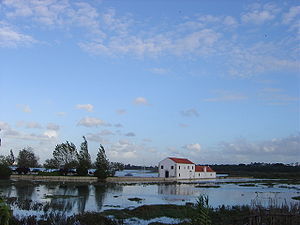
Moinho de Maré de Corroios
Encyclopedia

Corroios
Corroios is a Portuguese town and parish, located in the municipality of Seixal. It has a 2001 population of 46,475 inhabitants and a total area of 16.92 km² and the density is 2,746.9/km². Corroios remains as the second most populous town in Portugal, after Algueirão-Mem Martins...
, also the Moinho do Castelo was a building that was constructed in 1403 under the order of Nuno Álvares Pereira
Nuno Álvares Pereira
Dom Nuno Álvares Pereira, O. Carm. , also spelled Nun'Álvares Pereira, was a Portuguese general of great success who had a decisive role in the 1383-1385 Crisis that assured Portugal's independence from Castile...
. It was largely destroyed in the Earthquake of 1755. In 1980, the municipality of Seixal restored and became a part of the Municipal Ecomuseum (Ecomuseu Municipal). The Moinho de Corroios is one of the two rare which maintains in using the area by the Estuary of the Tejo. In early 2007, it closed down due to the continuing of the work of conservation and requalification. Said works ended in September 2009 and since then the Moinho de Corroios is open to the public once again.

